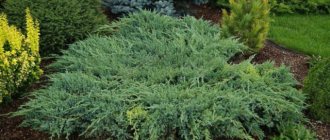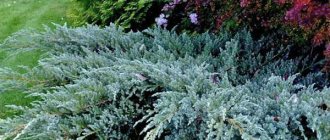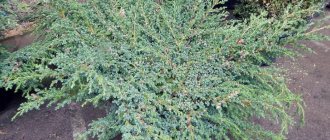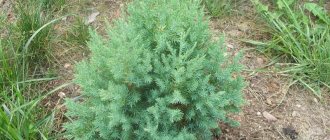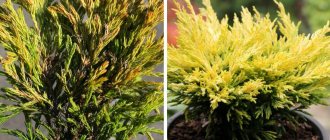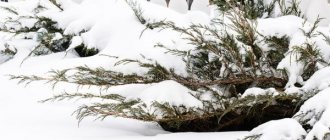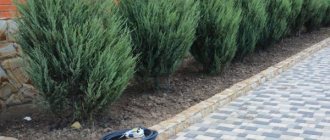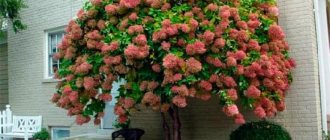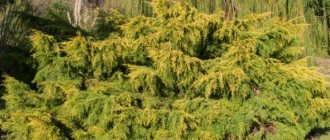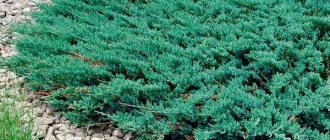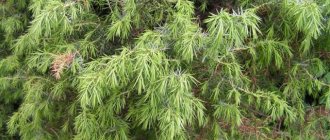Scaly juniper Holger: description of the variety
Let's look at the outstanding characteristics of this variety:
- The branches of this shrub are horizontal, drooping, self-sufficient, spreading.
- Has a small stature.
- The shoots located in the center have sharp ends and grow straight upward.
- The branches that are located below are located at a short distance from the ground; they grow in a horizontal plane. The shoots on these bushes are uneven.
- The tops of the lower stems can protrude from one hundred and fifty centimeters to two hundred centimeters.
- The average lifespan of scaly juniper is more than two hundred years. This variety grows very slowly, about five to seven centimeters per year. Over ten years, on average, a shrub can grow one hundred and fifty centimeters. He will already be an adult. The maximum growth of this shrub is seventy centimeters.
- The size and appearance of shrubs depends entirely on environmental parameters and care.
- For this variety, dry air is a negative factor.
- Whatever is best for the plant during the growing season, it is necessary that there be a body of water nearby.
- The crown may begin to thin out and the needles to shrink if the humidity in the area where the juniper grows is too high and the area is dark most of the time.
- Due to excessively wet soil, various rots may develop and plants may die.
This variety of juniper may be grown throughout Russia, except for the very north. The variety can bring frosts down to minus thirty-five degrees. If the shoots for some reason are damaged in winter, then during the growing season the bush will recover.
Juniper care
After planting, it is important to provide the plant with proper care. The quality of the needles, their color and the decorativeness of the shoots will depend on the skill of its implementation.
Juniper care includes:
- watering;
- feeding;
- loosening;
- mulching;
- pruning;
- preparation for winter;
- disease prevention and pest control.
Juniper has the ability to adapt to environmental conditions . This plant is extremely easy to care for, but during dry periods it requires shading. You can cover the plant with a light cloth to protect young shoots from burns.
External signs of juniper scaly Holger
Juniper Holger: photo
The width at its base is approximately four centimeters. The branches are light gray in color and rough. The needles are located quite close to each other, and they have a scaly shape. At the base of the branches it looks more like needles. At the very bottom the branches are usually gray in color, as they rise upward they become bluer. If the plant is young, the needles on it will be yellow. In winter, the color of the needles changes.
The cone-berries of this variety are of medium size, they are formed annually, and they also contain essential oils. The color of the cone berries is similar to steel.
The root system is fibrous; it grows in a horizontal plane at a shallow depth. Scaly juniper cones can be used in preparing various dishes; they are not poisonous.
Scaly juniper Holger in landscape design
Since this variety is painted quite brightly - with three single colors - it looks decorative and is often used in the field of landscape design to decorate areas.
This variety is often used to decorate cities; for example, it can be found in parks, squares and flower beds. This variety is simply necessary when designers design heather gardens, various areas near estates and flower beds in front of administrative buildings.
Juniper scaly Holger in garden landscape design: photo
Next to what you can plant a real variety in landscape design.
Holger can be planted either as a single plant or to create various compositions. The best combinations are considered to be this shrub with thujas and various heather plants.
- This type of juniper can be used to highlight the beauty of flowers: roses or barberries. Holger also looks good against the background of dwarf coniferous trees.
- Most often, this plant is used for decoration: ridges, ponds, slopes on rocky terrain, flower beds.
- You can also find it in the alpenarium and near the stones in the rock garden.
Coastal juniper varieties
Coastal juniper is represented by a wide variety of varieties. Each one is unique in its own way and has its own characteristics of care. To decorate your plot with juniper, you need to know the main characteristics of varietal plants.
Did you know? Juniper can be found in literary sources under a different name
—
archa.
Schlager (Juniperus communis Schlager)
The Schlager variety can be characterized as a ground cover shrub about 30 cm high and about 2.5 m wide. The needles are represented by long, prickly green needles. A silver stripe is noticeable on the inside of the needles. The peculiarity of the variety is its unpretentiousness to moisture and soil composition. Most often, these shrubs are used to decorate rock gardens and areas with a rocky soil structure.
Golden Wings
The height of specimens of the Golden Wings variety by the age of 10 is only 0.2-0.3 m, and the crown diameter is no more than 1 m. The shrub does not grow more than 50 cm in height. The needles are characterized by moderately hard needles. Its yellow-green hue with a golden tint gives this plant a special visual value in landscape design. Shrubs have good frost resistance.
Blue Pacific
The Blue Pacific variety has creeping shoot growth. Plants up to 30 cm high can have a crown diameter of 200 cm. The needles are needle-shaped, prickly, green with a blue tint. The variety is resistant to dry climate conditions and grows in frost hardiness zones 5–9.
Silver Mist
Silver Mist is a variety with a flat, blue crown. It is denser than other varieties of coastal juniper. The height of Silver Mist specimens is no more than 50 cm, and the diameter ranges from 80 to 90 cm. The shrubs grow in growth quite quickly, compared to other types of juniper. On average, their growth is about 10 cm in height and 15–20 cm in width annually. The crown is uneven and consists of skeletal branches, which tend to twist chaotically. The color of the needles is blue or light blue, with a silvery tint. The shade of the needles remains unchanged in any season of the year.
Emerald Sea
Shrubs of the Emerald Sea variety, when vegetating, create a kind of carpet from their branches. It grows slowly, at 10 years the height of the plant does not exceed 25 cm and width - 180 cm. The needles are green with a blue tint. The variety prefers to grow in sandy and sunny areas. The plant is well suited for strengthening slopes and slopes.
Juniper scaly Holger: planting and care
Adequate sunlight is important for this juniper variety, but slightly shaded areas are also suitable.
Holger loves light and tolerates not very dry air and lack of water.
There are no special conditions for the soil; in principle, you can use any soil as long as the soil is not heavy and has good drainage.
How to prepare seedlings and area for planting?
- At the time of planting, the seedling must be thirty-five to thirty-six months old.
- You can buy seedlings or grow them yourself.
- If you purchased a seedling that has an exposed root, it must be disinfected with a solution of potassium permanganate so that future growth progresses normally.
How to stratify the planting site for this variety.
- Ten to fifteen days before planting the plant, the area must be dug up and sand, peat and humus added to the soil.
- Since juniper’s root system is not very large, the hole should not be narrower than nine to ten centimeters, but should be at least sixty-five to seventy centimeters deep.
- The very first layer in the hole should be drainage, its depth is about nineteen to twenty centimeters.
- For training, you can use gravel or broken bricks.
How to plant a real variety.
Let's consider a few recommendations for planting this variety:
- If the root system of your future plant is open, then it needs to be placed in a fairly thick clay solution.
- You need to pour soil into the holes and make a small mound in the center.
- Next, carefully lower the seedling inside and distribute all the roots.
- We fill everything with earth so that at least nine to ten centimeters remain to the edge of the surface. The last nine to ten centimeters must be filled with sawdust.
- The root collar should not be deepened.
- Provided that the plant has a closed root system, you need to dilute the root in the required concentration and water the young seedling.
- The circle around the main trunk needs to be covered with mulch.
How to plant?
The variety is a light-loving crop, so planting should be done in a well-lit area. The most preferred soil type is sandy loam or loam. The soil should be moderately moist and contain nutritional components. If the soil is heavy and clayey, it is recommended to supplement it with a mixture of peat, sand and garden soil. You can also add coniferous soil containing useful organic matter.
Broken brick or sand is placed at the bottom of the planting hole as drainage. Juniper is quite tolerant of drought and can grow in poor soil, but excess water can destroy the plant, so do not neglect the organization of the drainage system.
To improve the composition, you can add Kemira-universal and nitrophoska. In order for the seedling to better adapt to new conditions, you can sprinkle the growth stimulator Epin under it. After planting, the young specimen must be wrapped in material to protect it from direct sunlight. A distance of at least 0.5 m should be maintained between two plantings.
The variety can be grown from seeds. Planting material is collected at the end of summer, planting is carried out immediately, however, the first shoots will hatch only after 2-3 years. The fact is that juniper seeds have a dense shell, which slows down germination. To ensure uniform germination, the grains can be cleared of pericarp and scarified before planting. Gardeners advise adding a small amount of soil from under juniper plantings to the seed furrows to introduce mycorrhiza.
How to properly water this variety.
Let's look at a few recommendations for watering this variety.
- How many times you water your plants depends on how many times it has rained.
- On average, a plant needs about nine to ten liters of water per day.
- Provided that the juniper is located far from natural bodies of water and the weather is hot enough, sprinkling will have to be done in the morning and evening.
Fertilizers and fertilizing for scaly juniper Holger
Let's consider several recommendations for carrying out activities for fertilizing and feeding this variety.
- Up to thirty-five to thirty-six months, plants are fed in the fall using universal complex products.
- Up to thirty-five to thirty-six months, plants are fed in the fall using complex mineralized fertilizers.
- After thirty-five to thirty-six months, the bushes are not fed.
How to properly carry out the mulching procedure for this variety
- After planting, the seedlings must be mulched. Chopped tree bark is most often used as mulch. This is both decorative and helps the plant retain the necessary moisture.
- In the autumn, you need to add more peat or dry grass on top.
- Every spring the mulch is renewed.
Loosening rules
- Until the lower branches grow sufficiently, the plants will need to be loosened.
- Loosening is necessary when weeds take over the area near the plants.
Formation and cutting of unnecessary shoots.
Juniper scaly Holger: photo
As mentioned above, juniper grows quite slowly per year. Let's look at a few recommendations for carrying out the pruning procedure for this variety.
- In order for the shape that you need to form, you need to trim the plant approximately once every twelve months.
- The crop pruning procedure must be carried out in the spring. This must be done before the sap begins to move.
- Most often, the crown of this shrub is left as it grows, because it is very lush and beautiful.
- Before the start of the growing season, that is, at the beginning of spring, it will be necessary to remove all dead branches and frozen shoots.
- Crown formation can be done after the plants have outgrown the thirty to thirty-five centimeter mark.
How to properly care?
As mentioned earlier, juniper is an extremely unpretentious plant, so even a novice gardener can handle caring for it. In winter, you need to monitor the branches, because with a huge amount of snow they can break. The same applies to the crown of the plant. To prevent this from happening, it is necessary to tie them in the autumn.
If the plant has increased sensitivity to daily temperature changes, it should be covered with special material in winter and spring. This method also helps perfectly protect the plant from sunburn, which causes yellow tints to appear on the bush. In spring and summer, it is necessary to water regularly, as well as add fertilizing important for growth and development.
It would also be useful to spray the plant with a solution of microfertilizers. This procedure helps the juniper maintain its green color even in winter.
As for pruning, it must be done as carefully as possible, following important rules
Regular pruning of shrubs can ensure ventilation of the internal space and prevent the occurrence of such an unpleasant disease as fungus. In addition, pruning allows you to remove all dead and dried parts of the plant. This procedure can be carried out several times a year.
The best periods are considered to be spring, late summer and the very beginning of autumn. It is important to know that the very first pruning of the bush can be done only a year after planting. Directly on the day of the procedure, the air and climate should be humid, and the plant itself should be thoroughly sprayed.
To complete the work you will need:
- pruner;
- garden shears with long handles;
- lopper;
- hacksaw.
How to prepare juniper for winter?
Let's look at a few recommendations for preparing this variety for the winter:
- In the autumn, the mulch must be increased by another ten centimeters.
- If the plant is young, it needs to be hilled up and covered with straw on top.
- Even though juniper tolerates cold temperatures well, under the snow its fragile shoots can begin to break.
- During winter, it is necessary to lift all the branches up and secure them with a rope.
- If the plant is young, it would be better to cover it with branches of coniferous trees or cover it with fabric material.
- To prevent the bush from freezing during severe frosts, you can cover it with snow.
Juniper Holger: recommendations for variety propagation
There are three main methods (not counting the rarely used) by which the scaly Holger juniper is propagated. Let's take a closer look at them.
- The cone berries contain normal seeds that can be used to propagate the plant; this method is called generative.
- Another method of propagation is through layering. In order for the branch to take root by autumn, it must be lowered into the ground and fixed with the onset of warmth, in the spring.
- You can propagate juniper using two-year-old shoots and cuttings. Planting material should be about fifteen to seventeen centimeters long.
- The most rarely used method is grafting a tall sprout onto a stamp.
Reproduction of juniper Holger
Juniper juniperus squamata Holger (scaly Holger) can be propagated on the site in several ways:
- Generative method. The culture produces full-fledged seeds that fully retain the varietal characteristics of the parent bush.
- Layering from the lower branches. To obtain a seedling in the spring, the lower branch is fixed to the ground and covered with soil; by autumn it will take root.
- Using cuttings from 2-year-old shoots, cut material 12-15 cm long.
Less commonly used is the method of grafting onto the trunk of a tall seedling.
Dangers that can await juniper Holger scaly
The possibility of developing various diseases of this variety.
Scaly juniper Holger is protected from various fungal and bacterial diseases. It is recommended to refrain from planting this shrub next to apple trees or fruit trees, as they may contribute to the development of pine rust on the juniper.
The possibility of damage to this variety by various insect pests.
Juniper sawfly. The false caterpillar of this pest can eat the leaf right down to the veins. An adult specimen of the larva, up to ten millimeters in length, overwinters in a dense cocoon woven from cobwebs. They choose a place for wintering in the soil near the bushes, at a depth of up to one hundred and fifty millimeters. With the arrival of the spring period, pupation occurs, that is, at the time when the foliage begins to bloom, the larvae transform into butterflies, and immediately lay eggs on the lower part of the leaf, along the veins. One insect can lay up to one hundred and forty eggs. And within ten to eleven days new larvae will appear. Their body is green and their head is brown. In one summer period, an insect can produce two or three generations.
Is there an anthill near the juniper? Your plant may be infected with aphids .
Scale insects can also be parasitic . These insects appear quite rarely, mainly when the hike is dry and the humidity is almost zero.
Prevention and disposal measures.
- To prevent aphid attacks, you can get rid of anthills, and if the aphids have already attacked, you should remove the shoots on which they live.
- You can get rid of these insects using chemicals, that is, insecticides.
- To get rid of juniper sawfly, you need to treat the crown with Karbofos.
- In order to carry out preventive treatment, preparations with a high copper content are used.
Diseases and pests
Scaly juniper is resistant to fungal and bacterial infections. It is not recommended to plant the crop near apple trees; proximity to a fruit tree causes the development of needle rust. Of the garden pests that parasitize shrubs:
- Juniper sawfly. If detected, treat the crown with Karbofos.
- Juniper is often attacked by aphids; its appearance is provoked by ants. Pests are eliminated as follows: cut off areas of the main localization of the colony, get rid of anthills.
- The scale insect is a less common parasite; the insect appears in dry weather with minimal air humidity. Destroy scale insects with insecticides.
For preventive purposes, scaly juniper Holger is treated with copper-containing preparations.
